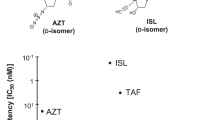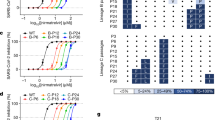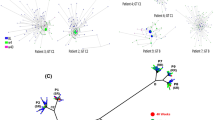Abstract
WILD-TYPE reverse transcriptase has evolved for the survival of human immunodeficiency virus type 1 (HIV-1) by natural selection1. In contrast, therapy relying on inhibitors of reverse transcriptase by nucleosides like zidovudine (AZT) or dideoxyinosine (ddl), and by non-nucleosides like pyridinones or nevirapine2–6, may exert different selection pressures on this enzyme. Therefore the acquisition of resistance to reverse transcriptase inhibitors by selection of mutations in the pol gene7–15 may require compromises in enzyme function that affect viral replication. As single mutations are unlikely to confer broad resistance when combinations of reverse transcriptase inhibitors are used, multiple mutations may occur that result in further compromises. Certain drug combinations may prevent the co-existence of adequate reverse transcription function and multi-drug resistance (MDR). Unlike bacterial or eukaryotic drug resistance, retroviral drug resistance is conferred only by mutations in its own genome16 and is limited by genome size. Combining drugs directed against the same essential viral protein may thus prevent HIV-1 MDR, whereas the conventional approach of targeting different HIV-1 proteins for combination therapy may not, because genomes with resistance mutations in different HIV-1 genes might recombine to develop MDR17. Here we show that several mutations in the HIV-1 reverse transcriptase gene that confer resistance to inhibitors of this enzyme can attenuate viral replication. We tested whether combinations of mutations giving rise to single-agent resistance might further compromise or even abolish viral replication, and if multidrug-resistant viruses could be constructed. Certain combinations of mutations conferring resistance to AZT, ddl and pyridinone are incompatible with viral replication. These results indicate that evolutionary limitations exist to restrict development of MDR. Furthermore, a therapeutic strategy exploiting these limitations by using selected multidrug regimens directed against the same target may prevent development of MDR. This approach, which we call convergent combination therapy, eliminated HIV-1 replication and virus breakthrough in vitro, and may be applicable to other viral targets. Moreover, elimination of reverse transcription by convergent combination therapy may also limit MDR.
This is a preview of subscription content, access via your institution
Access options
Subscribe to this journal
Receive 51 print issues and online access
$199.00 per year
only $3.90 per issue
Buy this article
- Purchase on Springer Link
- Instant access to full article PDF
Prices may be subject to local taxes which are calculated during checkout
Similar content being viewed by others
References
Temin, H. M. J. AIDS 2, 1–9 (1989).
Pauwels, R. et al. Nature 343, 470–474 (1990).
Merluzzi, V. J. et al. Science 250, 1411–1413 (1990).
Goldman, M. E. et al. Proc. natn. Acad. Sci. U.S.A. 88, 6863–6867 (1991).
Romero, D. L. et al. Proc. natn. Acad. Sci. U.S.A. 88, 8806–8810 (1991).
Balzarini, J. et al. Antimicrob. Ag. Chemother. 36, 1073–1080 (1992).
Larder, B. A. & Kemp, S. D. Science 246, 1155–1158 (1989).
St. Clair, M. H. et al. Science 253, 1557–1559 (1991).
Nunberg, J. H. et al. J. Virol. 65, 4887–4892 (1991).
Richman, D. et al. Proc. natn. Acad. Sci. U.S.A. 88, 11241–11245 (1991).
Prasad, V. R., Lowy, I., De Los Santos, T., Chiang, L. & Goff, S. P. Proc. natn. Acad Sci. U.S.A. 88, 11363–11367 (1991).
Mellors, J. W. et al. Molec. Pharmac. 41, 446–451 (1992).
Kellam, P., Boucher, C. A. B. & Larder, B. A. Proc. natn. Acad. Sci. U.S.A. 89, 1934–1938 (1992).
Gao, Q., Gu, Z., Parniak, M. A., Li, X. & Wainberg, M. A. J. Virol. 66, 12–19 (1992).
Fitzgibbon, J. E. et al. Antimicrob. Ag. Chemother. 36, 153–157 (1992).
Coen, D. M. J. Antimicrob Chemother. 18, Suppl. B 1–10 (1986)
Hu, W.-S. & Temin, H. M. Science 250, 1227–1233 (1990).
Eron, J. J., Gorczyca, P., Kaplan, J. C. & D'Aquila, R. T. Proc. natn. Acad. Sci. U.S.A. 89, 3241–3255 (1992).
Boucher, C. A. B. et al. J. infect. Dis. 165, 105–110 (1992).
Albert, J. et al. J. Virol. 66, 5627–5630 (1992).
Land, S., McGavin, C., Lucas, R. & Birch, C. J. infect. Dis. 166, 1139–1142 (1992).
Larder, B. A., Kemp, S. D. & Purifoy, D. J. M. Proc. natn. Acad. Sci. U.S.A. 86, 4803–4807 (1989).
Johnson, V. A., Barlow, M. A., Merrill, D. P., Chou, T.-C. & Hirsch, M. S. J. infect Dis. 161, 1057–1067 (1990).
Yarchoan, R., Mitsuya, H., Myers, C. E. & Broder, S. New Engl. J. Med. 321, 726–738 (1989).
Kunkel, T. A., Roberts, J. D. & Zakour, R. A. Meth. Enzym. 154, 367–382 (1987).
Ratner, L. et al. AIDS Res. hum. Retrovir. 3, 57–69 (1987).
Sanger, F., Nicklen, S. & Coulson, A. R. Proc. natn. Acad. Sci. U.S.A. 74, 5463–5467 (1977).
Kornfeld, H., Riedel, N., Viglianti, G. A., Hirsch, V. & Mullins, J. I. Nature 326, 610–613 (1987).
Aldovini, A. & Walker, B. Techniques in HIV Research (Stockton, New York, 1990).
Johnson, V. A. et al. J. infect Dis. 164, 646–655 (1991).
Author information
Authors and Affiliations
Rights and permissions
About this article
Cite this article
Chow, YK., Hirsch, M., Merrill, D. et al. Use of evolutionary limitations of HIV-1 multidrug resistance to optimize therapy. Nature 361, 650–654 (1993). https://doi.org/10.1038/361650a0
Received:
Accepted:
Issue Date:
DOI: https://doi.org/10.1038/361650a0
This article is cited by
-
Combinatorial therapy with two pro-coagulants and one osmotic agent reduces the extent of the lesion in the acute phase of spinal cord injury in the rat
Intensive Care Medicine Experimental (2017)
-
Antiretroviral drug resistance in HIV-1
Current Infectious Disease Reports (1999)
-
Closing in on human immunodeficiency virus–1
Nature Medicine (1996)
-
Interleukin-2 and human immunodeficiency virus infection: Pathogenic mechanisms and potential for immunologic enhancement
Immunologic Research (1996)
-
A model for treatment strategy in the chemotherapy of AIDS
Bulletin of Mathematical Biology (1996)
Comments
By submitting a comment you agree to abide by our Terms and Community Guidelines. If you find something abusive or that does not comply with our terms or guidelines please flag it as inappropriate.



